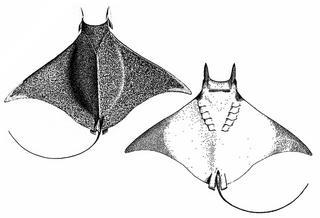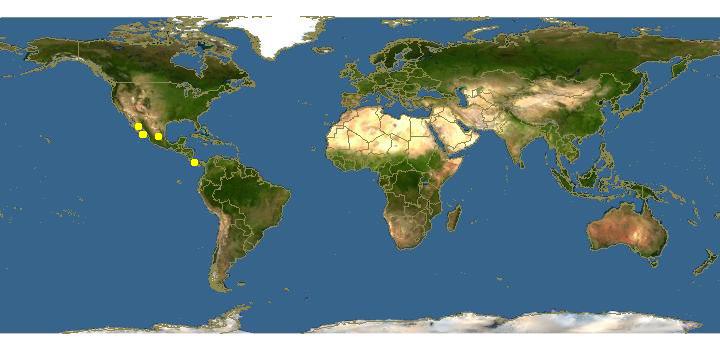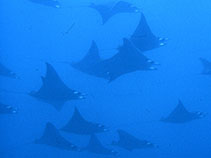
www.fao.org Copyright Michel Lamboeuf · 0
Mobula munkiana |

Click on map for details about points.
|
| Links |
We parsed the following live from the Web into this page. Such content is managed by its original site and not cached on Discover Life. Please send feedback and corrections directly to the source. See original regarding copyrights and terms of use.
- FishBase
|
|
español |
|
|
Overview |
Main identification features
- head narrow
- tail medium, no spine, base compressed
- mouth ventral
- belly: white, wings - tips dark
- dwarf - 1.1 m
Munk's mobula, Munk's devil ray, Pigmy devil ray
Disc strongly rhomboidal, much wider than long; wings strongly pointed; head wide, projecting from disc; pectoral fins extend along head and form two large soft horns; eyes and spiracles on side of head; front margin of the pectoral fin ends above and before spiracle; mouth ventral; small teeth on both jaws; length of tooth bands 54-65% of mouth width; teeth wider than long, smooth tips, ~triangular filter plates in gills separate at tips; tail long, slender with small dorsal fin at base, a little shorter than disc width, with compressed base and without spine.
Upper surface black, purple or purplish grey; lower surface white, with outer half of pectorals blue-grey.
Size: 220 cm wide.
Habitat: schooling, pelagic in coastal and oceanic waters.
Depth: to 30 m.
Gulf of California to Peru; the Galapagos, Cocos and Malpelo.
Attributes
Abundance: Common.
Cites: Not listed.
Climate Zone: North Temperate (Californian Province &/or Northern Gulf of California); Northern Subtropical (Cortez Province + Sinaloan Gap); Northern Tropical (Mexican Province to Nicaragua + Revillagigedos); Equatorial (Costa Rica to Ecuador + Galapagos, Clipperton, Cocos, Malpelo).
Depth Range Max: 30 m.
Depth Range Min: 0 m.
Diet: pelagic fish larvae; pelagic fish eggs; zooplankton; Pelagic crustacea; bony fishes.
Eastern Pacific Range: Northern limit=32; Southern limit=-4; Western limit=-115; Eastern limit=-78; Latitudinal range=36; Longitudinal range=37.
Egg Type: Live birth; No pelagic larva.
Feeding Group: Planktivore.
FishBase Habitat: Pelagic.
Global Endemism: Tropical Eastern Pacific (TEP) endemic; East Pacific endemic; All species.
Habitat: Water column.
Inshore Offshore: Inshore; Offshore; In & Offshore.
IUCN Red List: Not evaluated / Listed.
Length Max: 220 cm.
Regional Endemism: Island (s); Continent; Continent + Island (s); TEP endemic; All species.
Residency: Resident.
Salinity: Marine; Marine Only.
Water Column Position: Near Surface; Surface; Water column only;
|
|
|
Names | |
|
|
|
Links to other sites | |
|
|
|
References |
- Acero , A. and Franke, R., 1995., Nuevos registros de peces cartilaginosos del Parque Nacional Natural Gorgona (Pacifico Colombiano), II. Rayas y Descripcion de una Nueva Especie., Bibl. J. J. Triana, 11:9-21.
- Compagno, L.J.V., 1999., Checklist of living elasmobranchs. In Hamlett W.C. (ed.) Sharks, skates, and rays: the biology of elasmobranch fishes., The John Hopkins University Press:471-498.
- Findley, L.T., Hendrickx, M.E., Brusca, R.C., van der Heiden, A.M., Hastings, P.A., Torre, J., 2003., Diversidad de la Macrofauna Marina del Golfo de California, Mexico., CD-ROM versión 1.0. Projecto de la Macrofauna del Golfo . Derechos reservados de los autores y Conservación Internacional.
- Fischer , W. , Krup , F. , Schneider , W. , Sommer , C. , Carpenter , K. E. and Niem, V. H., 1995., Guia FAO para la Identificacion de Especies de para los fines de la Pesca. Pacifico Centro-Oriental. Volumen II. Vertebrados - Parte 1., FAO2:647-1200.
- Galván-Magaña, F., Abitia-Cárdenas, L.A., Rodríguez-Romero, J., Pérez-España, H., Chávez-Ramos, H., 1996., Systematics list of the fishes from Cerralvo island, Baja California Sur, Mexico., Ciencias Marinas, 22:295-311.
- Jimenez-Prado, P., Béarez, P., 2004., Peces marinos del Ecuador continental / Marine fishes of continental Ecuador., SIMBIOE/NAZCA/IFEA tomo 1 y 2.
- Notarbartolo di Sciara,., 1987., A revisionary study of the genus Mobula Rafinesque, 1810 (Chondrichthyes: Mobulidae) with the description of a new species., Zoological Journal of the Linnean Society, 91:1-91.
- Ramírez Rodríguez, M., 1997., Producción pesquera en la Bahía de La Paz, B.C.S.. En Urbán Ramírez, J. y M. Ramírez Rodríguez (Eds.). La Bahía de La Paz investigación y conservación., Universidad Autónoma de Baja California Sur:273-282.
- Van der Heiden , A. M. and Findley, L. T., 1988., Lista de los peces marinos del sur de Sinaloa, México., Anales del Centro de Ciencias del Mar y Limnologia de la Universidad Autonoma Nacional de Mexico, 15:209-224.
|
|
|
Acknowledgements | |
I thank Ashley MacDonald and John Pickering, University of Georgia, for technical support in building this page.
|
|
| Supported by | |
|
Following modified from FishBase
|
Top | See original
http://www.fishbase.org/Summary/speciesSummary.php?genusname=Mobula&speciesname=munkiana ---> http://52.67.158.155/Summary/speciesSummary.php?genusname=Mobula&speciesname=munkiana
http://52.67.158.155/Summary/speciesSummary.php?genusname=Mobula&speciesname=munkiana ---> https://fishbase.net.br/Summary/speciesSummary.php?genusname=Mobula&speciesname=munkiana
https://fishbase.net.br/Summary/speciesSummary.php?genusname=Mobula&speciesname=munkiana ---> https://fishbase.net.br/summary/Mobula-munkiana.html
Mobula munkiana, Munk's devil ray : fisheries

You can
sponsor
this page
Common name (e.g. trout)
Genus + Species (e.g. Gadus morhua)
-

-
About this page
-
Languages
-
User feedbacks
-
Citation
-
Uploads
-
Related species
-


 Munk's devil ray
Add your observation in
Fish Watcher
Upload your
photos
and
videos
Munk's devil ray
Add your observation in
Fish Watcher
Upload your
photos
and
videos
Pictures
|
Google image
 Mobula munkiana
Mobula munkiana
Picture by
Wirtz, P.
Elasmobranchii (sharks and rays) >
Myliobatiformes
(Stingrays) >
Mobulidae
(Devilrays)
Etymology:
Environment: milieu / climate zone / depth range / distribution range
Ecology
Marine; pelagic-oceanic; oceanodromous (Ref.
51243
); depth range 0 - 15 m (Ref.
58018
). Tropical; 32°N - 7°S, 114°W - 77°W (Ref.
114953
)
Eastern Pacific: From Gulf of California to Peru, incl. the Galapagos Is. (Ref.
130539
).
Size / Weight / Age
Maturity: L
m
?
range ? - ? cm
Max length : 220 cm WD male/unsexed; (Ref.
28023
); common length : 100.0 cm WD male/unsexed; (Ref.
9256
)
Pelagic species forming schools in coastal and oceanic waters, but also found near the bottom. Found singly, in small groups, or in schools (Ref.
12951
). Feeds mainly on planktonic crustaceans, but also takes small schooling fishes (Ref.
12951
). Ovoviviparous (Ref.
50449
). Gestation period unknown (Ref.
114953
).
Life cycle and mating behavior
Maturity
|
Reproduction
|
Spawning
|
Eggs
|
Fecundity
|
Larvae
Exhibit ovoviparity (aplacental viviparity), with embryos feeding initially on yolk, then receiving additional nourishment from the mother by indirect absorption of uterine fluid enriched with mucus, fat or protein through specialised structures (Ref.
50449
).
McEachran, J.D. and G. Notarbartolo di Sciara
, 1995. Mobulidae. Mantas, diablos. p. 759-764. In W. Fischer, F. Krupp, W. Schneider, C. Sommer, K.E. Carpenter and V. Niem (eds.) Guia FAO para Identification de Especies para los Fines de la Pesca. Pacifico Centro-Oriental. 3 Vols. FAO, Rome. (Ref.
9256
)
IUCN Red List Status (Ref.
130435
)
Vulnerable (VU)
(A2d+3d); Date assessed:
09 November 2018
CITES
Appendix II:
International trade monitored
Appendix I & II:
Endangered migratory species conserved through agreements
Threat to humans
Harmless
Human uses
Fisheries: commercial
FAO - Publication:
search
|
FishSource
|
More information
Countries
FAO areas
Ecosystems
Occurrences
Introductions
Stocks
Ecology
Diet
Food items
Food consumption
Ration
Common names
Synonyms
Metabolism
Predators
Ecotoxicology
Reproduction
Maturity
Spawning
Spawning aggregation
Fecundity
Eggs
Egg development
Age/Size
Growth
Length-weight
Length-length
Length-frequencies
Morphometrics
Morphology
Larvae
Larval dynamics
Recruitment
Abundance
BRUVS
References
Aquaculture
Aquaculture profile
Strains
Genetics
Electrophoreses
Heritability
Diseases
Processing
Nutrients
Mass conversion
Collaborators
Pictures
Stamps, Coins Misc.
Sounds
Ciguatera
Speed
Swim. type
Gill area
Otoliths
Brains
Vision
Tools
E-book
|
Field guide
|
Length-frequency wizard
|
Life-history tool
|
Point map
|
Classification Tree
|
Catch-MSY
|
Special reports
Check for Aquarium maintenance
|
Check for Species Fact Sheets
|
Check for Aquaculture Fact Sheets
Download XML
Summary page
|
Point data
|
Common names
|
Photos
Internet sources
AFORO (otoliths) |
Aquatic Commons
|
BHL
|
Cloffa
|
BOLDSystems
|
Websites from users
|
Check FishWatcher
|
CISTI
|
Catalog of Fishes
:
genus
,
species
|
DiscoverLife
|
ECOTOX
| FAO - Publication:
search
|
Faunafri
| Fishipedia |
Fishtrace
| GenBank:
genome
,
nucleotide
|
GloBI
|
Google Books
|
Google Scholar
|
Google
| IGFA World Record |
MitoFish
|
Otolith Atlas of Taiwan Fishes
|
PubMed
| Reef Life Survey | Socotra Atlas |
Tree of Life
| Wikipedia:
Go
,
Search
| World Records Freshwater Fishing |
Zoobank
|
Zoological Record
Estimates based on models
Preferred temperature (Ref.
123201
): 22.2 - 28.5, mean 23.5 °C (based on 368 cells).
Phylogenetic diversity index (Ref.
82804
): PD
50
= 0.5005 [Uniqueness, from 0.5 = low to 2.0 = high].
Bayesian length-weight: a=0.01000 (0.00244 - 0.04107), b=3.04 (2.81 - 3.27), in cm total length, based on all LWR estimates for this body shape (Ref.
93245
).
Trophic level (Ref.
69278
): 3.8 ±0.60 se; based on food items.
Resilience (Ref.
120179
): Low, minimum population doubling time 4.5 - 14 years (Fec assumed to be <100).
Fishing Vulnerability (Ref.
59153
): Very high vulnerability (85 of 100).
Price category (Ref.
80766
):
Medium
.
Back to Search
Random Species
Back to Top
Accessed through:
Not available
FishBase mirror site :
Laguna, Philippines
Page last modified by :
mrius-barile
|
Updated: 2024-04-25 11:44:41 gmt
|